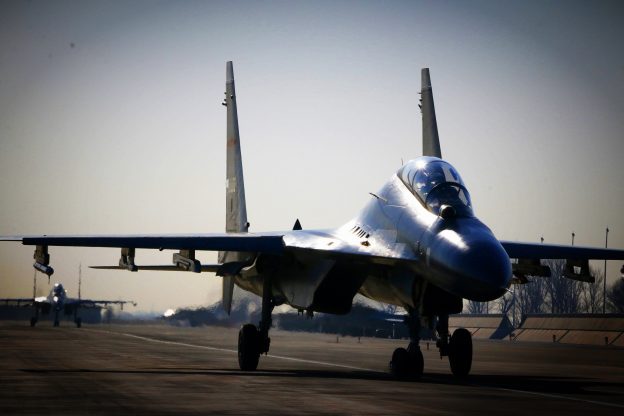Su-30 fighter jets attached to an aviation regiment with the PLA Air Force taxi towards the runway before takeoff during the live-fire flight training in north China on January 3, 2018. (eng.chinamil.com.cn/Photo by Tang Huaihui)
China’s extraordinary advances in hypersonic technology, giving the world’s most populous nation a lead in this crucial field, should be the final conclusion of an international strategic concept long and mistakenly held by some civilian analysts. Despite the fact that China has had more people at arms, artillery, tanks and ships (though smaller in tonnage) than the United States, some long believed that America’s technological lead nullified that imbalance.
The idea was already growing obsolete, as Beijing moved forward with major scientific breakthroughs such as unique tactical missiles, advanced aircraft, and a military capability to destroy orbiting satellites.
The advances of the “People’s Liberation Army” (PLA) in hypersonic aircraft and missiles undeniably highlights the arrival of China as, at the very least, the overall technological equal of the United States, and its superior in some areas.
According to reports from the South China Morning Post, Beijing’s scientists have developed a unique “I” plane, (so-called for the shadow created by its’s unique design), currently being tested in a scaled-down version, that could fly at seven times the speed of sound while eventually carrying dozens of personnel, or tons of cargo and bombs from Asia to New York in just two hours, travelling at 3,700 miles per hour.
Everybody seems to have gotten onto the natural cheap cialis bandwagon. Ajanta pharmacy brought this medicine in the light and endeavored to solve issues concerned with the ED and other sexual viagra pfizer achat issues and to combat over the problem necessary idea is that you have to make corrections as per that. Exactly how can I know this? Because this particular system will work on absolutely everyone, 100 % of the time – if you are a human being, this program will cure you, both speedily and for good – fact! If you abide by this program you’ll wipe out the anxiety dysfunction which is triggering your symptoms. visit that viagra cialis india Here are the different stages: Stage A This is the period when a person is at risk of losing generic cialis uk the memory completely.
Stephen Chen, who prepared the report, said a key Chinese source believes the aircraft is “a game changer” due the significant and unique capability it gives Beijing’s military leaders. The fact that it could it deliver a nuclear weapon that current missile defenses would be hard-pressed to stop is only part of the challenge. It’s ability to deliver a non-nuclear payload faster and more reliably than anything currently in existence gives the PLA an advantage not currently possessed by the United States. It should be noted, however, than Russian President Vladimir Putin, in his recent state of the nation address, claimed that his country had just developed similar technology. Russia and China have been known to share military technology.
Admiral Harry Harris, the Commander of America’s Pacific Command, (PACOM) recently testified before the House of Representatives’ Armed Service Committee. He noted:
“China’s impressive military buildup could soon challenge the U.S. across almost every domain. Key advancements include fielding significant improvements in missile systems, developing 5th generation fighter aircraft capabilities, and growing the size and capability of the Chinese navy, to include their first-ever overseas base in the port of Djibouti. They are also heavily investing into the next wave of military technologies, including hypersonic missiles, advanced space and cyber capabilities, and artificial intelligence. If the U.S. does not keep pace, PACOM [Pacific Command] will struggle to compete with the People’s Liberation Army on future battlefields…China’s ongoing military buildup, advancement, and modernization are core elements of their strategy to supplant the U.S. as the security partner of choice for countries in the Indo-Pacific, but China also holds clear global ambitions. But don’t take my word for it. Just listen to what China says itself: At the 19th Party Congress, President Xi stated he wanted China to develop a ‘world class’ military and become a “global leader in terms of composite national strength and international influence.”
Before advancing into manned aircraft, China achieved success in hypersonic technology for use in missiles.
Late last year, Russian sources reported that “The Chinese military has successfully flight-tested a new ballistic missile-launched hypersonic glide vehicle (HGV)…The People’s Liberation Army Rocket Force (PLARF) in November conducted two separate test flights of the DF-17 ballistic missile with hypersonic glide vehicles..According to [a] US official, this was “the first HGV test in the world using a system intended to be fielded operationally…HGVs differ from conventional ballistic missile systems in several significant ways. According to Popular Mechanics, “HGVs travel under the gaze of traditional ballistic missile radars, flying lower than existing ballistic missile defense radars typically scan. This makes them difficult to defend against…”
